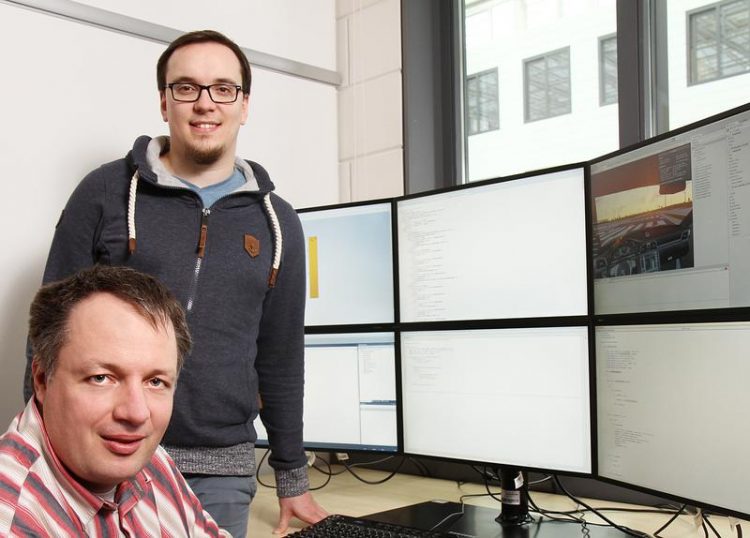Cebit 2017: A new simulation process makes complex hardware and software compatible

Researchers in Kaiserslautern, Dr. Thomas Kuhn (left) and Matthias Jung, developed a simulation method to verify in what combination hardware and software systems function correctly together. Credit: Thomas Koziel
More and more companies are tasked with such questions. A simulation method, developed by researchers in Kaiserslautern, will provide a solution. With this, they verify in what combination hardware and software systems function correctly together.
In addition, the researchers can examine the reaction of systems critical for safety in the occurrence of errors. At the Cebit computer trade fair in Hannover, researchers will present their technology at the research stand of Federal State Rhineland-Palatinate (hall 6, stand C17).
Joint press release by University of Kaiserslautern and Fraunhofer Institute for Experimental Software Engineering IESE
Nowadays, cars comprise a multitude of hardware and software components: for example, if all functions correctly, a sensor on the wheel of a car will detect whether the wheels are locked or the car is sliding. At the same time, other sensors monitor whether the brakes are functional. Here, these systems communicate simultaneously with each other.
Software systems comprise a multitude of such components. Developers must examine whether they are compatible with each other. “This is becoming increasingly complex with new hardware and software”, explains Matthias Jung, doctoral student at the Microelectronic Systems Design Research Group, led by Professor Dr. Norbert Wehn at the University of Kaiserslautern. “There are countless possibilities to combine such systems. It must always be determined whether the technology will run smoothly with the desired requirements”.
Together with the colleagues of Dr. Thomas Kuhn from the Fraunhofer Institute for Experimental Software Engineering IESE, researchers at the High Performance Center Simulation- and Software-based Innovation have developed a process, which is dedicated to such issues. “With our simulation platform FERAL, we can already examine whether hardware and software components will function together during development”, explains Dr. Kuhn, Head of Embedded Software Engineering at Fraunhofer IESE. “FERAL” is the abbreviation for Fast Evaluation on Requirements and Architectural Level.
“We can calculate a vast range of scenarios with this, whether for existing systems or new versions”, Dr. Kuhn continues. “Furthermore, we can for example test software and hardware that does not yet even exist using our virtual platform”.
With the process, researchers can also detect possible errors that are built into the technology. “This makes this method interesting for virtual product development”, explains Matthias Jung. The researchers provide the system as a service to middle-sized companies and large corporations. The technology is especially important for testing embedded systems. These microcomputers, that interact with their technical surroundings, are built into a multitude of products, including cars, aeroplanes, smartphones, as well as pacemakers and dialysis machines. Moreover, researchers can examine the reaction of systems critical for safety – such as in aeroplanes and industrial production plants – with regard to the occurrence of errors.
The team led by Kuhn and Jung have already collaborated with clients from the commercial vehicles industry and plant construction sector. They will present FERAL at the Cebit, at the research stand of Federal State Rhineland-Palatinate.
Contact persons:
Dipl.Ing. Matthias Jung
University of Kaiserslautern
Tel.: 0631 205- 3579
Email: jungma[at]eit.uni-kl.de
Dr. Thomas Kuhn
Fraunhofer Institute for Experimental Software Engineering IESE
Tel.: 0631 6800-2177
Email: thomas.kuhn[at]iese.fraunhofer.de
Media Contact
More Information:
http://www.uni-kl.deAll latest news from the category: Trade Fair News
Newest articles

First-of-its-kind study uses remote sensing to monitor plastic debris in rivers and lakes
Remote sensing creates a cost-effective solution to monitoring plastic pollution. A first-of-its-kind study from researchers at the University of Minnesota Twin Cities shows how remote sensing can help monitor and…

Laser-based artificial neuron mimics nerve cell functions at lightning speed
With a processing speed a billion times faster than nature, chip-based laser neuron could help advance AI tasks such as pattern recognition and sequence prediction. Researchers have developed a laser-based…

Optimising the processing of plastic waste
Just one look in the yellow bin reveals a colourful jumble of different types of plastic. However, the purer and more uniform plastic waste is, the easier it is to…



